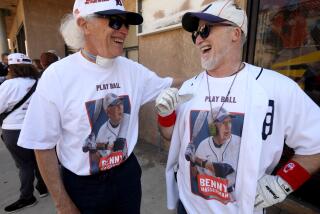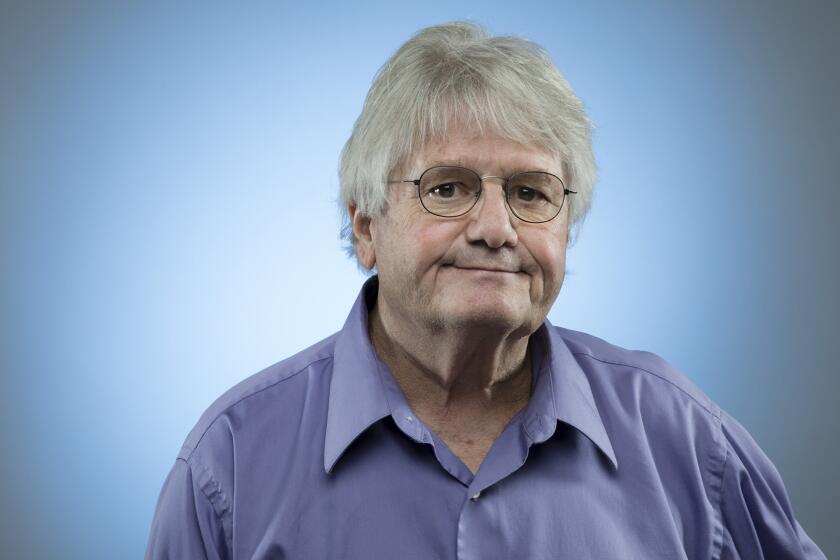Lawrence Herkimer, who jump-started modern cheerleading, dies at 89
When he was in high school, Lawrence Herkimer had a bad stutter. But when he was leading cheers for the football team, his elocution was perfect, his confidence unshakable, his destiny loud and proud.
Herkimer went on to start cheerleading camps throughout the U.S. and in several countries. He is credited with training some 3 million cheerleaders. He manufactured their outfits and patented an updated pompom — which he called pompon after hearing that “pompom” sounded like an obscene reference in Asian languages.
Early in his career, he created a cheerleading move — a splayed-leg leap with one hand punching the air and the other planted on a hip — that is still performed wherever teams grapple, bands play and pep reigns. It’s called “the Herkie.”
Lawrence “Herkie” Herkimer, who is acknowledged by many as the father of modern cheerleading, died July 1 in Dallas after a long illness, his family announced. He was 89.
Herkimer was neither the first nor the most famous U.S. cheerleader. At the first U.S. intercollegiate football game, in 1869, Princeton students urged their fellows on against Rutgers by chanting “Rah! Rah! Rah! Tiger! Tiger! Tiger! Sis! Sis! Sis! Boom Boom Boom Aah!” Rutgers won.
Four U.S. presidents were cheerleaders: Franklin D. Roosevelt, Dwight D. Eisenhower, Ronald Reagan and George W. Bush. So were Madonna and Justice Ruth Bader Ginsburg of the U.S. Supreme Court.
But Herkimer raised the bar, turning a collegiate pastime into an athletic discipline, and a ragtag operation that he started in his garage into a collection of companies that brought in $55 million annually. In 1987, he told the Dallas Morning News that he had led cheerleading “from the raccoon coat and megaphone to greater heights.”
“His contributions to our industry have gone far and wide,” said David Kirschner, a former Syracuse University cheerleader who heads the Studio City-based California High School Cheer and Dance Assn. “In essence, he was one of the original founders.”
“The Herkie jump is a skill that almost all cheerleaders are taught today,” Kirschner said. “It’s something that left an impression on cheerleaders throughout the country.”
The distinctive move originated as a mistake. Herkimer later told interviewers that it was “a poor split jump.”
“I was about 60 when I did my last one,” he told the New York Times in 2009. “I joke that it takes a crane and a piano wire to perform one now.”
Herkimer sold his National Cheerleaders Assn. and related companies in 1986 for $20 million.
“I couldn’t think like a 15-year-old girl anymore,” he said.
Herkimer was born in Muskegon, Mich., on Oct. 14, 1925, grew up in Dallas and studied physical education at Southern Methodist University.
A gymnast and cheerleader, he left school in 1943 for the Navy, returning to graduate in 1948. After receiving a master’s degree from the University of Illinois, he signed on with his alma mater, teaching gymnastics and statistics.
Meanwhile, he started the National Cheerleaders Assn. His first summer camp drew 52 girls and a boy. The next year, with 350 students, he quit his teaching job and went into cheerleading full time.
In 1951, his wife, Dorothy, started the Cheerleading Supply Co., manufacturing team sweaters, skirts, emblems, pennants and other supplies. She died in 1993.
In addition to selling millions of pompoms, Herkimer made and sold a forest’s worth of “spirit sticks” — decorated dowels given as rewards to cheerleaders especially brimming with spirit.
They got their start, he told an interviewer, in a 1957 cheer camp at the University of Redlands.
“We had a group out there who were real characters,” he said. “They had lots of spirit but almost no talent.”
Casting around for a way to recognize them, he tore a twig off a tree and deemed it a “spirit stick.”
Applauding attitude as well as athletics was part of Herkimer’s philosophy.
“The physical skills we teach the kids are just a part of it,” he said in a 1983 UPI interview. “We also teach how to build school spirit, we teach crowd control, we teach crowd psychology, we teach them what to do when a crowd boos, we teach how to plan a pep rally.”
In Texas, Herkimer was active in civic affairs, serving two terms on the Dallas Independent School Board. He was a leader in many organizations, including the Dallas Civic Garden Assn. and the Dallas Salesmanship Club.
While his hometown gave rise to the Dallas Cowboys Cheerleaders, one of the showiest squads in professional sports, Herkimer was not a huge fan.
“Professional cheerleaders are not cheerleaders,” he said. “They’re dancing girls and entertainers.”
Herkimer’s survivors include daughters Marilyn Herkimer Weber, Sharon Herkimer Dewberry and Carolyn Herkimer Cooper; seven grandchildren; and a sister, Bonnie Richards.
Twitter: @schawkins
More to Read
Start your day right
Sign up for Essential California for the L.A. Times biggest news, features and recommendations in your inbox six days a week.
You may occasionally receive promotional content from the Los Angeles Times.







